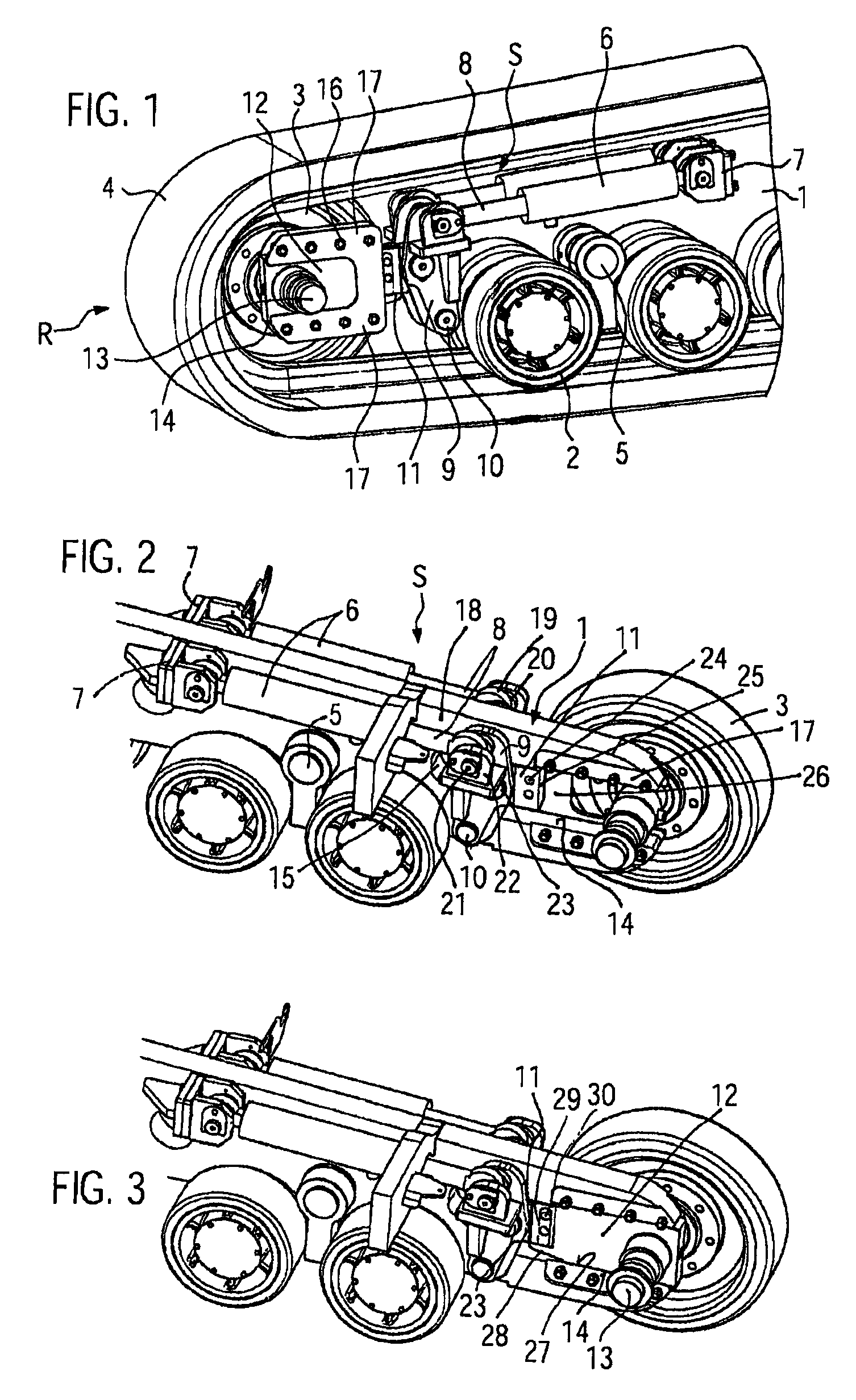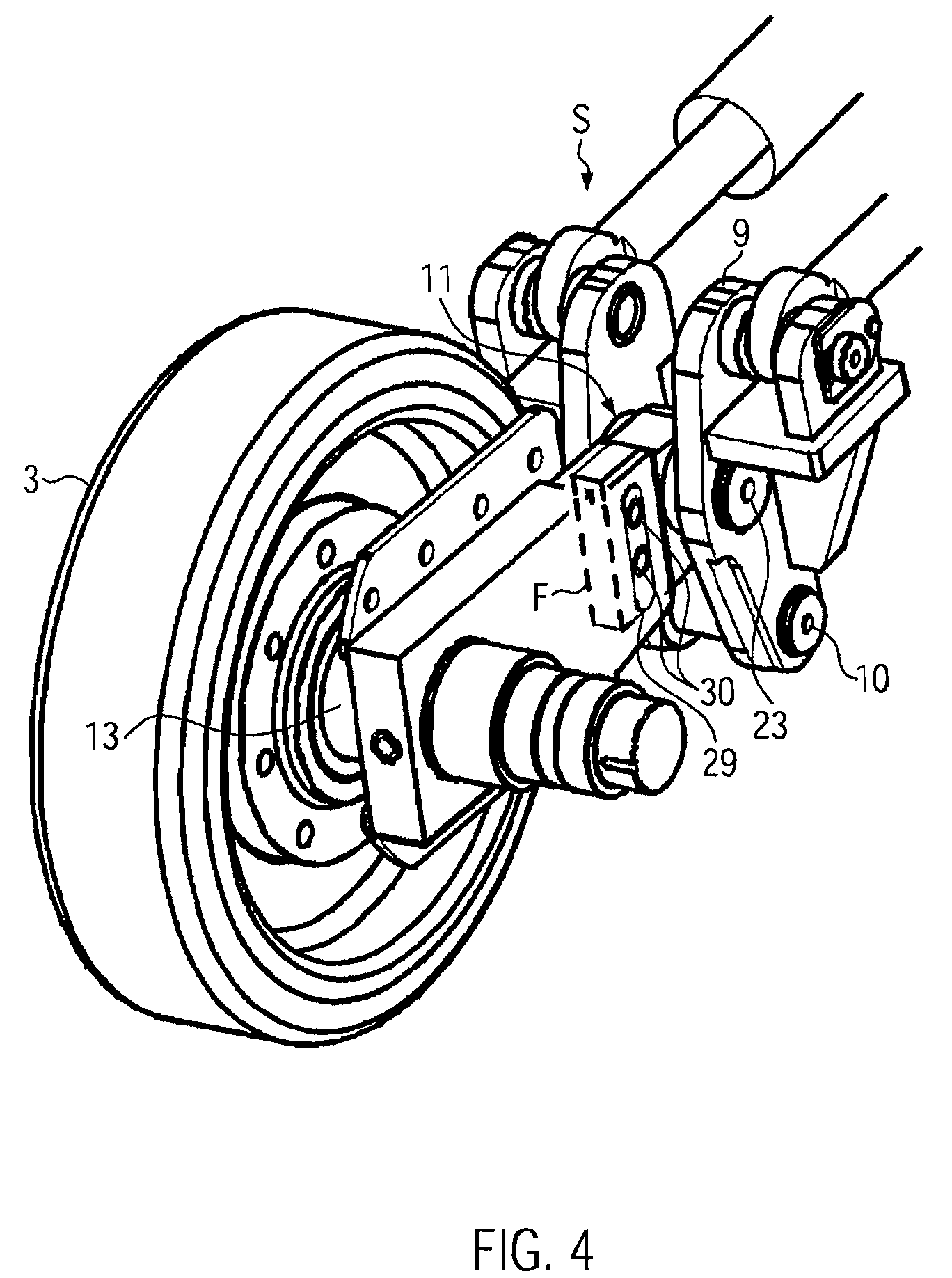[0006]As the at least one guide wheel is supported in the guide part, which in turn is guided exclusively linearly in the track carrier, the tensioning lever does not need to stabilize the guide wheel. A stable lateral support of the guide wheel is assured whenever the guide wheel yields counter to or moves due to the tensioning force of the tensioning member. The tensioning member transmits the tensioning force via the tensioning lever to the guide part and in turn to the guide wheel. However, this force transmission takes place without undesirable lateral forces since the slide block only allows for the transmission of forces to the guide wheel, which forces are oriented in the linear direction of the movement of the guide part, and because the slide block compensates for the differences in the movements of the pivoting tensioning lever and the linearly moving guide part. A favourably long lever force arm can be used for the tensioning lever, because the tensioning force is transmitted from the tensioning lever via the slide block to the guide part. A structural separation is provided between the lateral support of the guide wheel and the transmission of the tensioning force. The tensioning device has a compact size, allowing to provide a small distance only between the guide wheel and the next caster wheel. Furthermore, a small diameter guide wheel (or a guide wheel pair) may be implemented, because the laterally stably supported guide part even transmits large lateral forces directly to the track carrier. The surface pressure at the slide block is moderate, such that even for long service times, only low wear has to be expected.
[0008]The slide block is arranged on a pivot axis defining in the slide block a first force transmission area of a determined size. At the location where the slide block is in contact either with the guide part or with the tensioning lever, in order to transmit the tensioning force and the support force, a second force transmission area is defined, which is larger in size than the first force transmission area, in order to minimize wear between flat surfaces sliding on each other and to reduce the surface pressure.
[0012]In an expedient embodiment, the slide block is engaging into the guide part, such that the contact area between the slide block and the guide part is shielded to the exterior against contamination (lubricant stored inside). The slide block may have sidewardly protruding pins, which engage into lateral slots in the guide part, which slots are open from the inside to the outside. The engaging guiding pins prevent irregular relative movements of the slide block in contact with the guide part. Furthermore, the engagement of the pins allows to pull back the guide part via the slide block.
[0015]When the pins engaging into the slot or the slots are offset in relation to each other, they will prevent the slide block inadvertently pivoting about the pivot axis when the tensioning device is in unloaded condition.
[0018]The tensioning member bearing may comprise two bearing blocks at the tensioning lever in order to transmit large forces to the tensioning lever without wear and without lateral components. Both bearing blocks may be penetrated by a common linking pin. A lug of a piston rod e.g. may be linked to the linking pin. Expediently, a universal joint is provided between the lug of the piston rod and the linking pin, in order to prevent generating lateral force components between a piston rod of the tensioning member and the tensioning lever.
[0019]It may be expedient to match the positions of the pivot axis at the tensioning lever, of the track carrier pivot bearing and of the tensioning member at the track carrier with the positions of the guide part and the load bearing surface of the guide part, such that the direction of the tensioning force transmitted by the pivot axis is, at least substantially, parallel to the linear direction of the movement of the guide part. This concept avoids undesirable force components from the pivot movement of the tensioning lever, which force components would be inclined with respect to the guide part moving direction in the linear guiding jaw. Hence, the guide part can be moved smoothly and such that it underlies hardly any wear.
 Login to View More
Login to View More  Login to View More
Login to View More 


